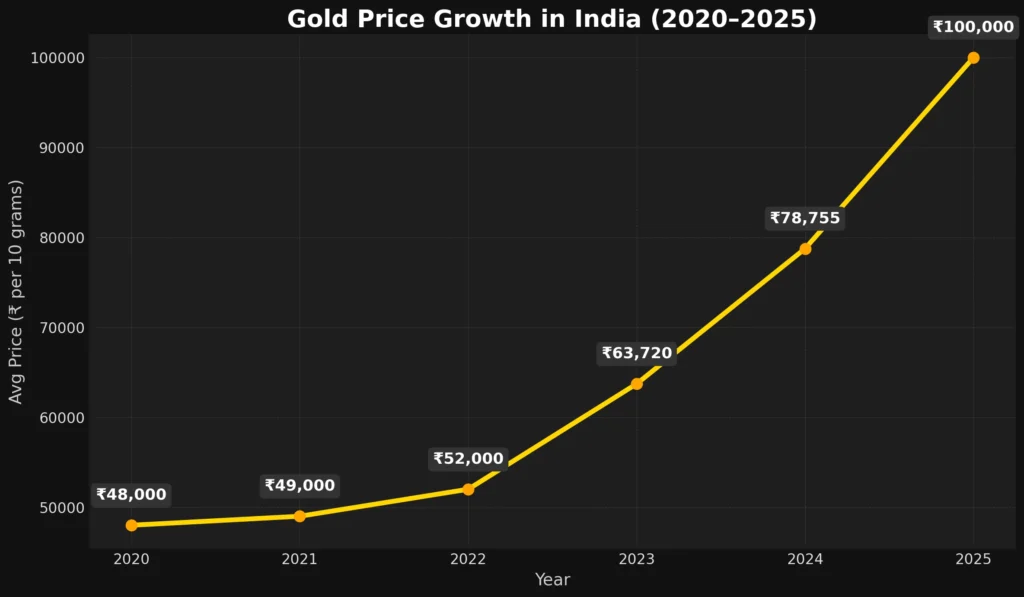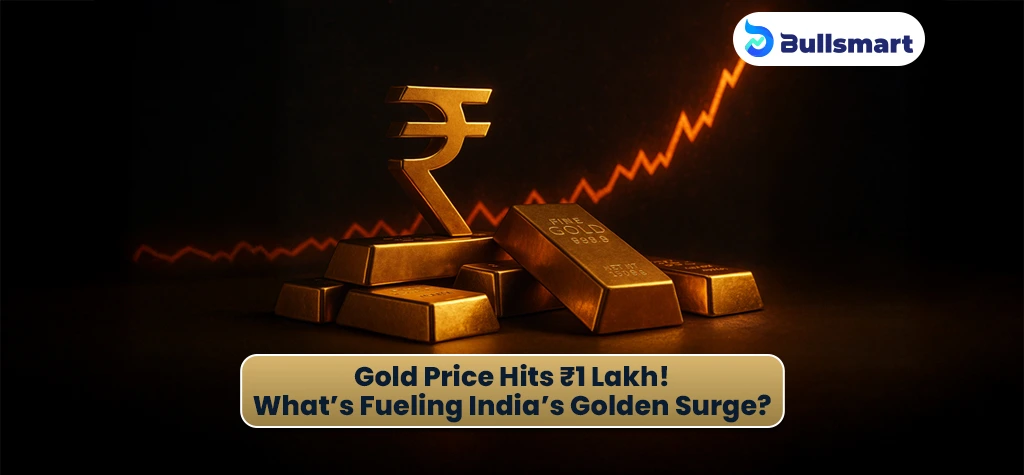Gold holds a special place in Indian hearts, whether it’s for weddings, festivals, or investments. But lately, gold prices have been soaring, grabbing everyone’s attention.
As of April 2025, gold prices in India have jumped over 31% this year, hitting around ₹1,00,000 per 10 grams (roughly $3,500 per troy ounce globally, or ₹2,83,000 per troy ounce at ₹83.3/$).
So, why is the gold price increasing?
Let’s break it down in simple terms for Indian readers, dive into recent trends, and see what’s next for gold.
What’s Driving Gold Prices Up in India?
Gold prices are influenced by global and local factors, from economic uncertainty to festive demand. Here are the key reasons behind the surge:
1. Economic Uncertainty and Safe-Haven Appeal
When the world feels unstable think global trade tensions or economic slowdowns—people turn to gold as a safe bet. In 2025, US-China trade disputes and new tariffs under Donald Trump have sparked fears of a global slowdown.
Posts on X show Indian investors rushing to gold to protect their wealth. This “safe-haven” demand has pushed prices to record highs, with gold hitting Rs 1 lakh per 10 grams recently.
2. Central Banks Stocking Up
Central banks, including India’s Reserve Bank of India (RBI), are buying gold like never before. In 2024, global central banks purchased over 1,000 tonnes for the third straight year, with 108 tonnes bought in December alone.
The RBI added 77 tonnes in 2024, taking its gold reserves to 878 tonnes. Why? Countries like India and China are reducing reliance on the US dollar, especially after events like the 2022 freezing of Russian assets. This buying spree has driven gold prices higher.
3. Inflation and Rupee Weakness
Inflation eats away at the value of money, making gold a trusted store of value. In India, inflation and a weaker rupee (around ₹83.3 per USD in 2025) have made gold pricier.
For example, gold hit ₹78,755 per 10 grams in October 2024 on the Multi Commodity Exchange (MCX) and climbed further as the rupee weakened. Globally, inflation fears also boost demand, as gold holds value better than cash.
4. Falling Interest Rates
Gold doesn’t earn interest, so it shines when interest rates drop. In 2025, expected rate cuts by the US Federal Reserve have made gold more attractive than fixed deposits or bonds.
In India, lower returns on savings accounts (3-6% annually) make gold a better option for preserving wealth. Global gold ETFs saw ₹783 billion (approx. $9.4 billion) in inflows in February 2025, reflecting this trend.
5. Festive and Cultural Demand
India is the world’s second-largest gold consumer, and gold is more than an investment it’s a cultural essential for weddings, Diwali, and Akshaya Tritiya. The 2024 festive season saw massive demand, with jewelers reporting a 20% sales spike.
This seasonal rush, combined with global trends, keeps prices high. For instance, demand surged during Dhanteras 2024, pushing local prices to ₹80,000 per 10 grams.
6. Limited Gold Supply
Gold supply isn’t keeping pace with demand. New gold from mines adds just 2-3% to global stocks yearly, and mining faces challenges like high costs (₹1,08,000 per ounce, or $1,300) and environmental rules.
Recycling is up 9% but not enough. With India importing 700-800 tonnes annually, this tight supply drives prices higher.
7. Investor Rush and ETF Inflows
Indian investors, from small savers to big institutions, are buying gold to hedge against stock market dips. The Sensex fell 5% in 2025, pushing people toward gold.
Globally, gold ETFs saw ₹391 billion ($4.7 billion) in inflows in February 2025, with India’s gold ETFs growing 15% in assets under management. This investor frenzy is fueling the price rally.
Recent Trends in the Gold Market
- Record Highs in 2024-2025: Gold prices in India rose from ₹63,720 per 10 grams in May 2023 to ₹78,755 in October 2024 and hit ₹94,000 by April 2025, a 47% jump in two years.
- RBI’s Gold Reserves: India’s central bank increased gold holdings by 77 tonnes in 2024, signaling strong confidence in gold as a reserve asset.
- De-Dollarization: India and other BRICS nations are diversifying away from the US dollar, boosting gold’s role in reserves.
- Jewelry and Investment Demand: India’s gold demand hit 813 tonnes in 2024, with jewelry (60%) and investment (40%) driving growth, per the World Gold Council.
- Industrial Uses: Gold’s use in electronics and medical applications (like cancer therapy) adds stable demand, though it’s a small fraction compared to jewelry.
Gold Price Growth Chart (2020-2025)
Here’s a look at the average annual gold prices in India (per 10 grams) to show the upward trend:
| Year | Average Price (₹/10 grams) |
| 2020 | 48,651 |
| 2021 | 47,910 |
| 2022 | 50,926 |
| 2023 | 60,456 |
| 2024 | 73,250 (Q4) |
| 2025 | 1,00,000 (April) |
This chart highlights gold’s steady rise, with a sharp spike in 2024-2025 due to global and local factors.
Glance at this chart for a visual showcase of the price uptrend:

Will Gold Prices Go Down?
Predicting gold prices is like guessing the weather—tricky! Experts have mixed views, and several factors could push prices up or down.
Let’s explore both sides for Indian investors.
Reasons Gold Prices Might Drop
- Higher Interest Rates: If global or Indian interest rates rise (e.g., RBI tightening policy), gold could lose shine as fixed deposits or bonds offer better returns. Analysts suggest prices could dip to ₹85,000 per 10 grams if rates stay flat.
- Increased Supply: High prices are encouraging more mining and recycling. Global gold stocks grew 9% to 216,265 tonnes in 2024. If supply outpaces demand, prices could fall to ₹50,500 per 10 grams by 2030, per some forecasts.
- Easing Tensions: If global trade disputes or geopolitical risks (like US-China tensions) cool off, investors might return to stocks, reducing gold demand.
- Speculator Moves: Speculators hold large bets on gold futures. A sell-off could lower prices short-term, possibly to ₹88,000 per 10 grams.
Reasons Gold Prices Might Stay High or Rise
- Central Bank Buying: The RBI and other central banks are expected to keep buying, with forecasts suggesting prices could hit ₹91,500-₹97,000 by end-2025. Stronger buying could push it to ₹1,00,000.
- Geopolitical Risks: Ongoing conflicts (e.g., Ukraine, Gaza) and trade wars keep gold as a safe haven.
- Inflation and Tariffs: New tariffs could spike inflation, making gold a preferred hedge. Some predict ₹97,000 per gram by 2030.
Pro Tip: You can use an inflation calculator to align your expenses better during times of dire need. - Festive Demand: India’s 2025 wedding season and festivals could sustain high demand, keeping local prices elevated.
Suggested Read: Silver vs. Gold: Reasons Why Silver Could Outshine Gold for Explosive Returns in 2025!
Expert Forecasts for India
- Bullish: Analysts predict ₹91,500-₹105,000 by end-2025, with long-term targets of ₹1,36,000 by 2027.
- Bearish: Some foresee a drop to ₹60,500 by 2030 if supply grows and demand cools.
- Long-Term: Assuming a 7.2% annual return, gold could reach ₹1,89,000 per 10 grams by 2040.
The Verdict
Gold prices might dip short-term if supply rises or global tensions ease, but the long-term outlook is strong due to central bank buying, festive demand, and inflation fears.
Indian investors should monitor RBI policies, global events, and the rupee’s value closely.
Listen to what the expert says:
Wrapping Up
The gold price is increasing due to a mix of global uncertainty, massive central bank purchases, inflation, falling interest rates, India’s festive demand, and limited supply.
The 31% surge in 2025 has taken prices to ₹1,00,000 per 10 grams, reflecting these trends. While short-term dips are possible, gold’s role as a safe and cultural asset keeps it shining.
Thinking of buying gold? It’s a great way to diversify, but don’t put all your money in it experts suggest 5-10% of your portfolio. Whether it’s jewelry for Diwali or gold ETFs for investment, stay informed about market trends and consult a financial advisor before diving in.
Gold’s sparkle isn’t fading anytime soon!
Disclaimer: Investments in securities market are subject to market risks, read all the related documents carefully before investing.
FAQs
Can gold prices reach 1 lakh?
Yes, gold prices in India have already crossed the ₹1 lakh mark per 10 grams. On April 22, 2025, 24-karat gold surged past ₹10,000 per gram, translating to over ₹1 lakh for 10 grams.
This unprecedented rise was driven by a combination of factors, including global economic uncertainties, heightened geopolitical tensions, and robust demand from central banks.
How much is 1 kg of gold today?
As of April 23, 2025, the price of 24-karat gold in India is approximately ₹9,835 per gram.
Therefore, 1 kilogram (1,000 grams) of 24K gold would cost around ₹98.35 lakh.
Please note that gold prices fluctuate daily based on market conditions.
Did gold cross 1 lakh?
Yes, gold prices in India crossed the ₹1 lakh threshold per 10 grams on April 22, 2025.
This milestone was achieved amid a global rally in gold prices, with spot gold reaching record highs due to investors seeking safe-haven assets during times of economic and geopolitical instability.
What will be the gold price in 2025?
Various forecasts suggest that gold prices could remain elevated throughout 2025:
- International projections estimate prices may touch $3,700–$4,500 per ounce depending on global risk levels.
- These levels, when converted to Indian prices factoring in current exchange rates and duties, imply that gold may stay around or above ₹1 lakh per 10 grams.
- High inflation, economic slowdowns, and increased demand from central banks are likely to support these elevated price levels.
How much is 1 gram of gold today?
As of April 23, 2025:
- 24-karat gold is priced at ₹9,835 per gram
- 22-karat gold is around ₹9,015 per gram
These rates may vary slightly based on location, jeweller margins, and applicable taxes.

